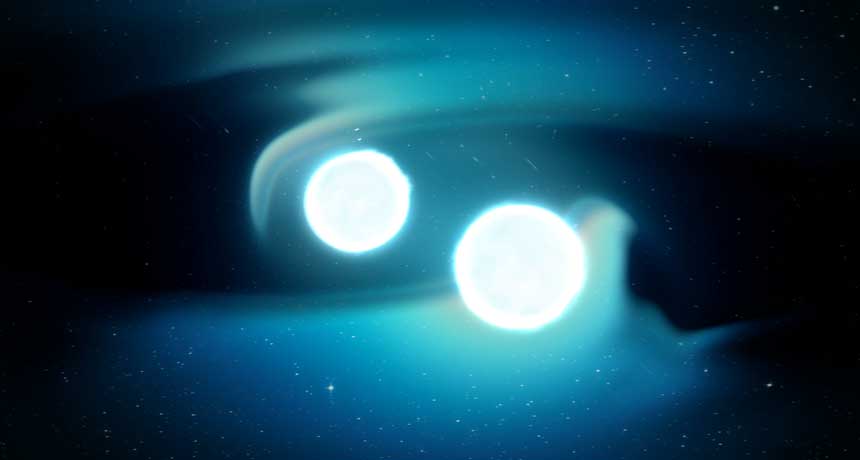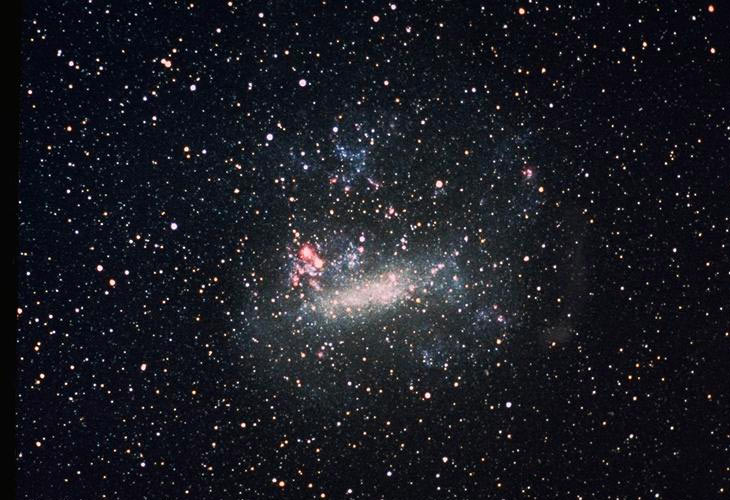
BANG, CRASH Physicists using the LIGO and Virgo observatories are catching all sorts of cosmic collisions, including of pairs of neutron stars (illustrated). But scientists hope to bag even more exotic quarry.
NASA’s Goddard Space Flight Center/CI Lab
- More than 2 years ago
Seekers of gravitational waves are on a cosmic scavenger hunt.
Since the Advanced Laser Interferometer Gravitational-wave Observatory turned on in 2015, physicists have caught these ripples in spacetime from several exotic gravitational beasts — and scientists want more.
This week, LIGO and its partner observatory Virgo announced five new possible gravitational wave detections in a single month, making what was once a decades-long goal almost commonplace (SN Online: 5/2/19).
“We’re just beginning to see the field of gravitational wave astronomy open,” LIGO spokesperson Patrick Brady from the University of Wisconsin–Milwaukee said May 2 in a news conference. “Opening up a new window on the universe like this will hopefully bring us a whole new perspective on what’s out there.”
The speed and pitch of gravitational wave signals allow astronomers to make out what’s stirring up the waves. Here are the sources of gravitational waves that scientists that already have in their nets, and what they’re still hoping to find.
1. Pairs of colliding black holes
Status: Found
LIGO’s first catch was a pair of colliding black holes, each around 30 times the mass of the sun (SN: 3/5/16, p. 6). The experiment detected vibrations from the merging black holes on September 14, 2015, four days before the official start of observations for the freshly upgraded LIGO.
That first discovery proved that massive, moving objects do in fact shake spacetime to produce gravitational waves, as Einstein predicted a century earlier. Not only that, the find proved that experiments on Earth could detect those waves, something of which Einstein was skeptical. Three of LIGO’s founders were awarded the Nobel Prize in physics in 2017 for the detection (SN: 10/28/17, p. 6).
In total, LIGO and Virgo have detected gravitational waves from 10 confirmed pairs of colliding black holes, plus another three candidates netted in the last month.
2. Pairs of colliding neutron stars
Status: Found
It was thought that a pair of merging neutron stars, the dense stellar corpses of massive stars that died in a supernova, could also set off gravitational waves. Then, in August 2017, the LIGO-Virgo team caught the first known instance of such an event, and a second on April 25 (SN: 11/11/17, p. 6).
COSMIC CHIRP Gravitational waves are analogous to sound waves. If human ears could hear the waves created by a pair of colliding neutron stars, they would sound like a low rumble as the neutron stars circled each other. Then, the sound would increase in pitch as the stars drew closer and closer, culminating in a faint “chirp” as the objects merged (around 29 seconds). |
Follow-up observations with telescopes that are sensitive to light across the electromagnetic spectrum revealed hidden details of that first neutron star crash, including that the collision forged precious elements like gold, silver and platinum.
3. A neutron star crashing into a black hole
Status: Maybe
Another type of merger that could spawn ripples in spacetime is like the chocolate-vanilla swirl at an ice cream stand: one black hole and one neutron star merging into a single object. The observatories saw a possible signature of this kind of merger on April 26, but the signal was too weak for scientists to be sure.
If the team confirms that that signal really represents a black hole and neutron star swirl, it would prove that the two kinds of objects can live side by side. Before merging, the black hole and neutron star would have had to orbit each other in a close binary system.
“We’d be surprised if they didn’t exist, but we haven’t seen one” of these combinations, says LIGO team member Christopher Berry of Northwestern University in Evanston, Ill.
Studying such a system could help illuminate the mysterious material called nuclear pasta that makes up neutron stars (SN: 10/27/18, p. 8). “Neutron stars are kind of like giant atomic nuclei. They’re nothing like what we can create on Earth,” Berry says. The neutron star merger spotted in 2017 gave some details of the stars’ makeup (SN: 12/23/17, p. 7), including their maximum mass and squishiness. Spying a black hole-neutron star merger could show how a neutron star deforms near the extreme gravity of a black hole, another piece in the puzzle of how nuclear pasta behaves.
4. A collision involving an intermediate-mass black hole
Status: Not yet
All the black holes that LIGO and Virgo have detected so far have been stellar mass, which means that they typically weigh less than 100 times the mass of the sun. Physicists also know of supermassive black holes that weigh millions or billions times the mass of the sun (SN: 4/27/19, p. 6). But it’s not clear if there are black holes with masses in between.
Such intermediate-mass black holes “could be the link between stellar mass black holes and supermassive black holes in the centers of galaxies,” Virgo team member Giovanni Andrea Prodi of the University of Trento in Italy said May 2 at a news conference.
Previous research has seen hints of such middleweight black holes, but a collision detected with gravitational waves would be more definitive proof. If they don’t exist, “that’s really interesting,” Berry says, because it would mean supermassive black holes must have been born bigger than physicists can explain (SN Online: 3/16/18).
5. A bumpy neutron star
Status: Not yet
Another way to steal the secrets of neutron stars’ mysterious nuclear pasta is to detect miniature “mountains” on their surfaces. All massive objects that accelerate generate gravitational waves, but most of them are too faint to detect. Physicists think that a lone neutron star with a slight imperfection on it, like a bump about a millimeter high, would emit detectable gravitational waves as it spins. Such waves could help tell how stiff the neutron star material can be, in order to support the bumps.
Unlike most other sources on this list, bumpy neutron stars would produce continuous gravitational waves, detected as a constant “hum” by the observatories.
6. Supernova explosions
Status: Not yet
LIGO and Virgo might also be able to pick up gravitational waves from supernova explosions, the bright cataclysms at the end of massive stars’ lives.
Supernovas emit many types of light and particles, including ghostly subatomic particles called neutrinos that are born deep in the heart of the explosions (SN: 2/18/17, p. 20). But scientists still don’t know exactly what makes a star explode as a supernova in the first place.

What they do know is that during a supernova explosion, the central core of the star collapses, and the resulting proto-neutron star gathers material from the remainder of the collapsing core. The turbulence at the surface of the proto-neutron star makes it vibrate like a bell, sending off gravitational waves. That specific gravitational wave signal is strongly related to the strength of the turbulence and the structure of the nascent neutron star, astrophysicist David Radice of Princeton University and colleagues report April 29 in the Astrophysical Journal Letters.
“Gravitational waves, neutrinos, and light from the next galactic supernova could allow us to understand the structure of the exploding star, and the nature of the mechanism powering its explosion,” Radice says.
The catch is that a supernova would have to be fairly close, in our own Milky Way galaxy, for the current LIGO detectors to catch it. And astronomers don’t know when the next supernova will happen (SN: 2/18/17, p. 24).
“The expected detection rate is only about two per century, so we will need to be really lucky, or very patient,” Radice says.
7. Waves triggered by the Big Bang
Status: Not yet
Physicists expect that many small gravitational waves from all over the universe crash into Earth all the time. These waves make up a random background of gravitational waves, like a jumble of voices in a crowded room.
Physicists think that at least some of those voices come from the Big Bang. Detecting relic gravitational waves generated by the Big Bang itself would mean seeing back further in the universe’s history than ever before. But it will be difficult to tease that signal apart from all the others.
“As you get a more sensitive detector, you may be able to pick out individual voices,” Berry says. “It’s currently an unsolved problem.”
8. New sources?
Status: Not yet
There’s still the possibility that detectors will catch gravitational waves from a source that scientists don’t recognize. Each time researchers have looked at the universe in a new way, they’ve discovered something that they didn’t predict, Berry says. “Now we’re looking in gravitational waves, a completely different kind of radiation,” he says. “It might be a bit arrogant to think we know everything that’s out there.”







